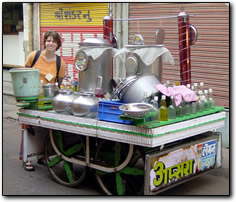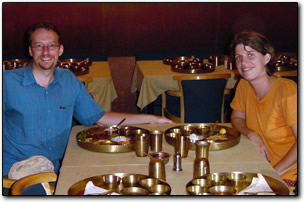Ahmedabad
Ahmedabad, the capital of Gujarat, is an interesting city. It is one of the industrial and textile capitals of India. There are some good museums, including one of the best textile museums in the world. The rambling, old city is divided into “pols”, or small neighborhoods that were traditionally sealed off at night. We took an excellent walking tour of the inner city and were shown the range of architectural styles in the narrow, meandering streets. Each pol had its own pigeon feeding station. Our guide explained to us that the Hindus believe that pigeons, because they are the only vegetarian bird, should be treated kindly. We met with some of Rahul's extended family who invited us to see their businesses. One of his cousins has his own clothing store. Not only did he and his wife design all of the outfits, but most of the fabric was their fabrication as well. They were very busy fitting customers for wedding season.
 |
 |
Ahmedabad is known for the Calico museum, perhaps one of the best museums in India, and certainly one of the best textile museums in the world. The museum is housed in a beautiful villa surrounded by gardens. A guided tour is the only way to see the collection. From sultan's tents to religious tapestries, weaving to embroidery, batik to tie-dying, the range spans every possible way to making and decorating textiles. Some of the pieces are fragile and can only be lit for viewing for a limited time. Everything is clean, well cared-for and beautifully displayed. The interiors are also decorated with Indian objects of high and folk art. Ahmedabad also has a folk museum with many fine examples of Kutch embroidery. After seeing the incredible crafts that they produce, we decided to visit this region in the western part of Gujarat.
In Ahmedabad we discovered Gujarati food. What wonderful cuisine! Most Gujaratis are vegetarians. The food was so good that we didn't miss the meat. Usually we ordered a “thali”, a plate with many small dishes of vegetables and curries, chutneys and yoghurt or curds, including tasty, hot chapatis (flatbreads). An “unlimited” thali consisted of endless helpings of dishes and chapatis. In the nicer restaurants, the waiters are constantly hovering around with additional bowls of food. As soon as one of the little thali dishes is even half empty, a waiter would come to serve another ladle to refill it with dal or vegetables. Many of the Gujarati dishes are sweet. Dal is usually sweetened with cane or palm sugar. We found very good restaurants in Ahmedabad, and always looked forward to our next meal.
 |
We enjoyed Ahmedabad, but after a few days the intense pollution started to bother us. By late mid-afternoon the air had became thick with dust, smoke and exhaust. A burnt, oily smell pervaded the air. By nightfall a thick, biting fog had covered the city. Our eyes began to water and burn. Soon Eric developed a hawking cough. Looking out of our hotel window, we could almost see the particles sparkling in the light of the street lamps. Pollution had been a big problem in all of the larger cities we had visited so far: Bombay, Aurangabad, Surat and now Ahmedabad, but we had never stayed long enough to be affected. Enough! We couldn't stand it anymore. It was time to move on.
